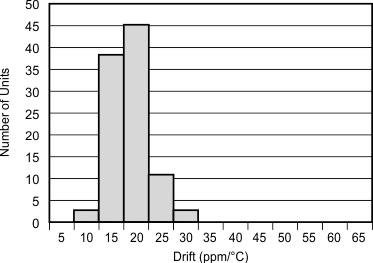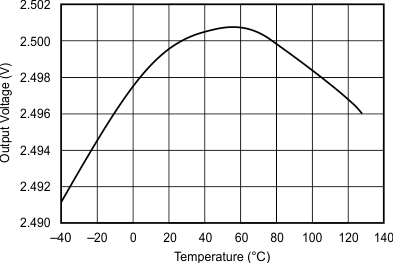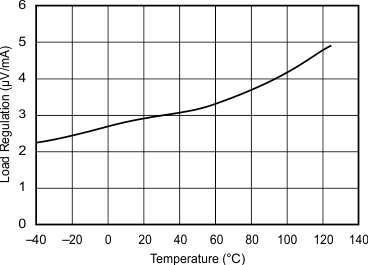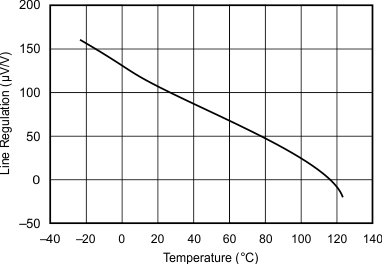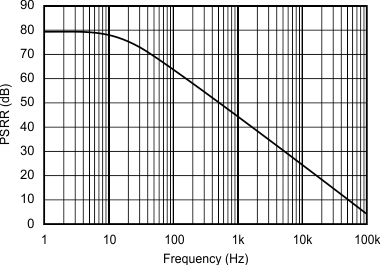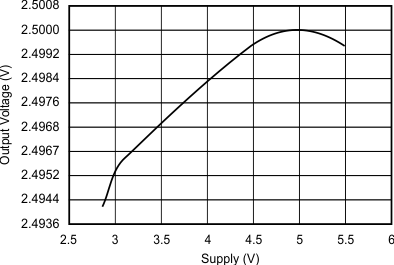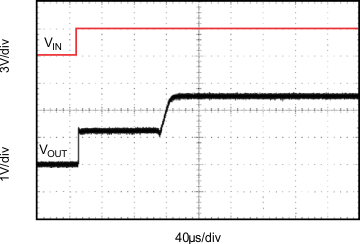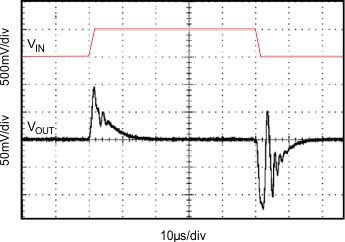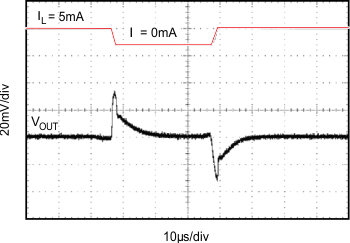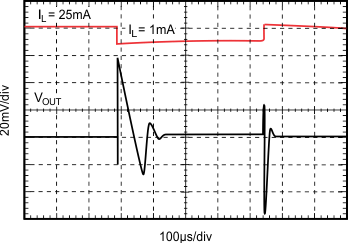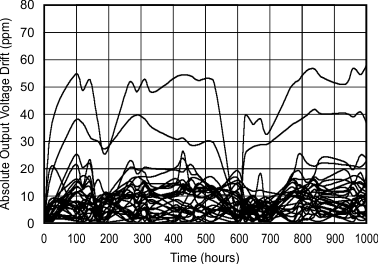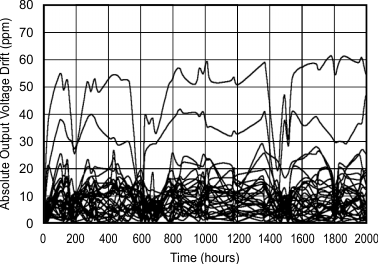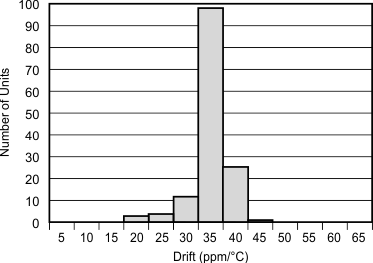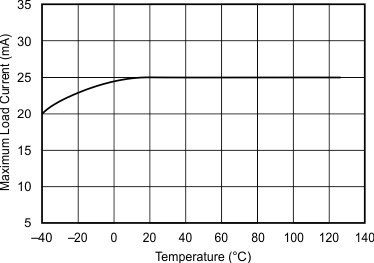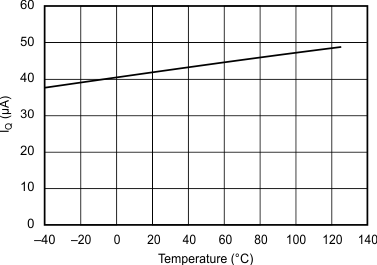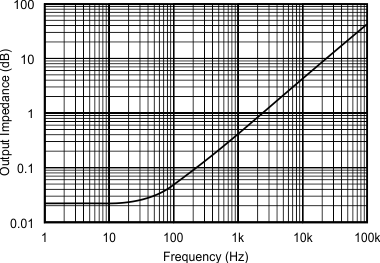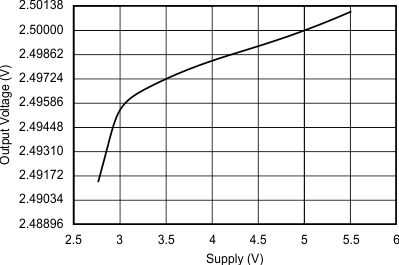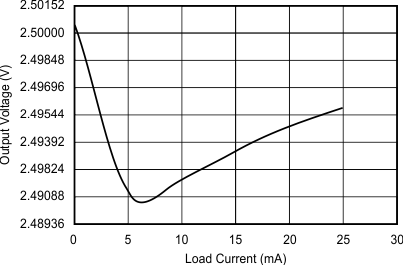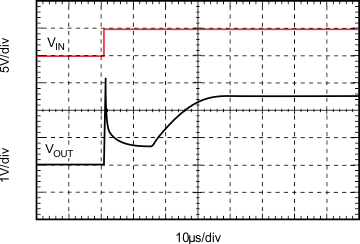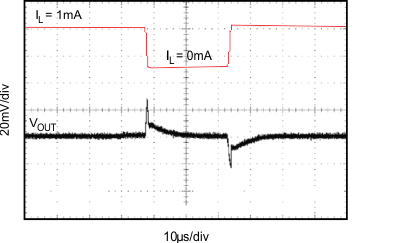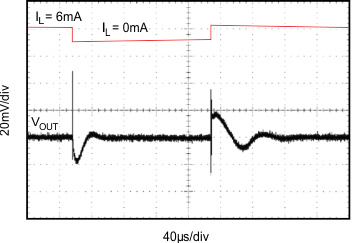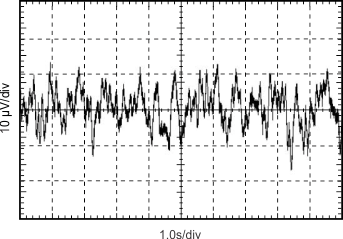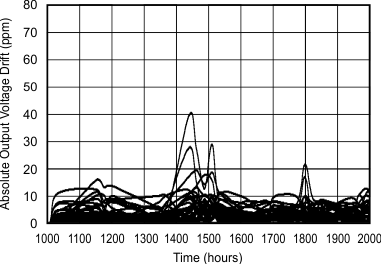SBVS033C June 2002 – June 2016 REF2912 , REF2920 , REF2925 , REF2930 , REF2933 , REF2940
PRODUCTION DATA.
- 1 Features
- 2 Applications
- 3 Description
- 4 Revision History
- 5 Device Comparison Table
- 6 Pin Configuration and Functions
- 7 Specifications
- 8 Detailed Description
- 9 Application and Implementation
- 10Power Supply Recommendations
- 11Layout
- 12Device and Documentation Support
- 13Mechanical, Packaging, and Orderable Information
Package Options
Refer to the PDF data sheet for device specific package drawings
Mechanical Data (Package|Pins)
- DBZ|3
Thermal pad, mechanical data (Package|Pins)
Orderable Information
7 Specifications
7.1 Absolute Maximum Ratings
over operating free-air temperature range (unless otherwise noted)(1)| MIN | MAX | UNIT | ||
|---|---|---|---|---|
| Supply voltage, V+ to V– | 7 | V | ||
| Output short circuit(2) | Continuous | °C | ||
| Lead temperature (soldering, 10 s) | 300 | °C | ||
| Operating temperature | –40 | 125 | °C | |
| Junction temperature | 150 | °C | ||
| Storage temperature, Tstg | –65 | 150 | °C | |
(1) Stresses beyond those listed under Absolute Maximum Ratings may cause permanent damage to the device. These are stress ratings only, which do not imply functional operation of the device at these or any other conditions beyond those indicated under Recommended Operating Conditions. Exposure to absolute-maximum-rated conditions for extended periods may affect device reliability.
(2) Short-circuit to ground.
7.2 ESD Ratings
| VALUE | UNIT | |||
|---|---|---|---|---|
| V(ESD) | Electrostatic discharge | Human-body model (HBM), per ANSI/ESDA/JEDEC JS-001(1) | ±4000 | V |
| Charged-device model (CDM), per JEDEC specification JESD22-C101(2) | ±1500 | |||
(1) JEDEC document JEP155 states that 500-V HBM allows safe manufacturing with a standard ESD control process.
(2) JEDEC document JEP157 states that 250-V CDM allows safe manufacturing with a standard ESD control process.
7.3 Recommended Operating Conditions
over operating free-air temperature range (unless otherwise noted)| MIN | MAX | UNIT | ||
|---|---|---|---|---|
| VIN | Input voltage | VREF + 0.05(1) | 5.5 | V |
| ILOAD | Load current | 25 | mA | |
| TA | Operating temperature | –40 | 125 | °C |
(1) Minimum supply voltage for the REF2912 is 1.8 V.
7.4 Thermal Information
| THERMAL METRIC(1) | REF29xx | UNIT | |
|---|---|---|---|
| DBZ (SOT-23) | |||
| 3 PINS | |||
| RθJA | Junction-to-ambient thermal resistance | 297.3 | °C/W |
| RθJC(top) | Junction-to-case (top) thermal resistance | 128.5 | °C/W |
| RθJB | Junction-to-board thermal resistance | 91.7 | °C/W |
| ψJT | Junction-to-top characterization parameter | 12.8 | °C/W |
| ψJB | Junction-to-board characterization parameter | 90.3 | °C/W |
| RθJC(bot) | Junction-to-case (bottom) thermal resistance | N/A | °C/W |
(1) For more information about traditional and new thermal metrics, see the Semiconductor and IC Package Thermal Metrics application report.
7.5 Electrical Characteristics
Boldface limits apply over the specified temperature range, TA = –40°C to 125°C. At TA = 25°C, ILOAD = 0 mA, VIN = 5 V, unless otherwise noted.| PARAMETER | TEST CONDITIONS | MIN | TYP | MAX | UNIT | |
|---|---|---|---|---|---|---|
| REF2912 – 1.25 V | ||||||
| VOUT | Output voltage | 1.225 | 1.25 | 1.275 | V | |
| Initial accuracy | 2% | |||||
| Output voltage noise | f = 0.1 Hz to 10 Hz, | 14 | µVPP | |||
| Voltage noise | f = 10 Hz to 10 kHz | 42 | µVrms | |||
| Line regulation | 1.8 V ≤ VIN ≤ 5.5 V | 60 | 190 | µV/V | ||
| REF2920 | ||||||
| VOUT | Output voltage | 2.007 | 2.048 | 2.089 | V | |
| Initial accuracy | 2% | |||||
| Output voltage noise | f = 0.1 Hz to 10 Hz, | 23 | µVPP | |||
| Voltage noise | f = 10 Hz to 10 kHz | 65 | µVrms | |||
| Line regulation | VREF + 50 mV ≤ VIN ≤ 5.5 V | 110 | 290 | µV/V | ||
| REF2925 | ||||||
| VOUT | Output voltage | 2.45 | 2.5 | 2.55 | V | |
| Initial accuracy | 2% | |||||
| Output voltage noise | f = 0.1 Hz to 10 Hz | 28 | µVPP | |||
| Voltage noise | f = 10 Hz to 10 kHz | 80 | µVrms | |||
| Line regulation | VREF + 50 mV ≤ VIN ≤ 5.5 V | 120 | 325 | µV/V | ||
| REF2930 | ||||||
| VOUT | Output voltage | 2.94 | 3 | 3.06 | V | |
| Initial accuracy | 2% | |||||
| Output voltage noise | f = 0.1 Hz to 10 Hz, | 33 | µVPP | |||
| Voltage noise | f = 10 Hz to 10 kHz | 94 | µVrms | |||
| Line regulation | VREF + 50 mV ≤ VIN ≤ 5.5 V | 120 | 375 | µV/V | ||
| REF2933 | ||||||
| VOUT | Output voltage | 3.234 | 3.3 | 3.366 | V | |
| Initial accuracy | 2% | |||||
| Output voltage noise | f = 0.1 Hz to 10 Hz, | 36 | µVPP | |||
| Voltage noise | f = 10 Hz to 10 kHz | 105 | µVrms | |||
| Line regulation | VREF + 50 mV ≤ VIN ≤ 5.5 V | 130 | 400 | µV/V | ||
| REF2940 | ||||||
| VOUT | Output voltage | 4.014 | 4.096 | 4.178 | V | |
| Initial accuracy | 2% | |||||
| Output voltage noise | f = 0.1 Hz to 10 Hz, | 45 | µVPP | |||
| Voltage noise | f = 10 Hz to 10 kHz | 128 | µVrms | |||
| VREF + 50 mV ≤ VIN ≤ 5.5 V | 160 | 410 | µV/V | |||
| REF2912, REF2920, REF2925, REF2930, REF2933, REF2940 | ||||||
| dVOUT/dT | Output voltage temperature drift(2) | –40°C ≤ TA ≤ 125°C | 35 | 100 | ppm/°C | |
| ILOAD | Output current | 25 | mA | |||
| Long-term stability | 0 to 1000H | 24 | ppm | |||
| 1000 to 2000H | 15 | |||||
| dVOUT/dILOAD | Load regulation(3) | 0 mA < ILOAD < 25 mA, VIN = VREF + 500 mV(1) |
3 | 100 | µV/mA | |
| dT | Thermal Hysteresis(4) | 25 | 100 | ppm | ||
| VIN – VOUT | Dropout voltage | 1 | 50 | mV | ||
| ISC | Short-circuit current | 45 | mA | |||
| Turnon settling time | to 0.1% at VIN = 5 V with CL = 0 | 120 | µs | |||
| POWER SUPPLY | ||||||
| VS | Voltage | IL = 0 | VREF + 0.001(5) | 5.5 | V | |
| Voltage over temperature | –40°C ≤ TA ≤ 125°C | VREF + 0.05 | 5.5 | |||
| IQ | Quiescent current | 42 | 50 | µA | ||
| Quiescent current over temperature | –40°C ≤ TA ≤ 125°C | 59 | ||||
| TEMPERATURE RANGE | ||||||
| Specified range | –40 | 125 | °C | |||
| Operating range | –40 | 125 | °C | |||
| Storage range | –65 | 150 | °C | |||
| RθJC | Thermal resistance for SOT-23 surface-mount | 110 | °C/W | |||
| RθJA | 336 | °C/W | ||||
(1) Minimum supply voltage for REF2912 is 1.8 V.
(2) Box Method used to determine overtemperature drift.
(3) Typical value of load regulation reflects measurements using a force and sense contacts, see Load Regulation.
(4) Thermal hysteresis procedure is explained in more detail in Thermal Hysteresis.
(5) For IL > 0, see Typical Characteristics.
7.6 Typical Characteristics
